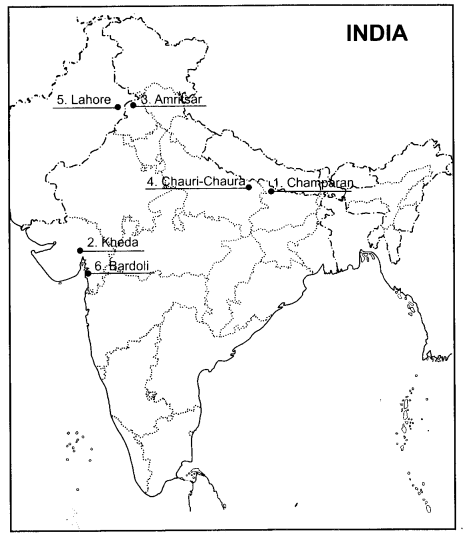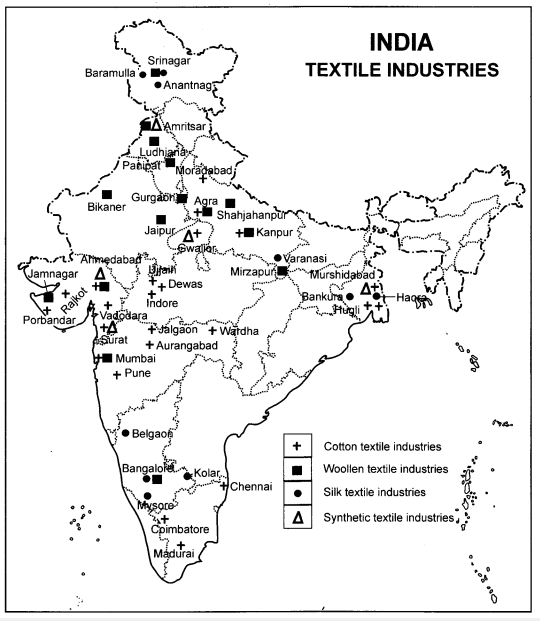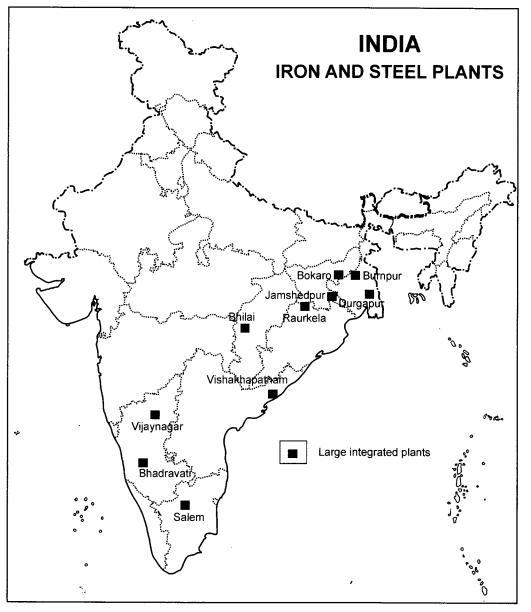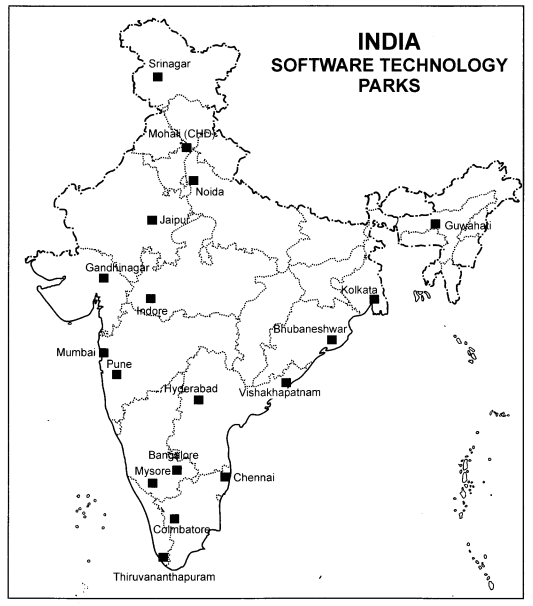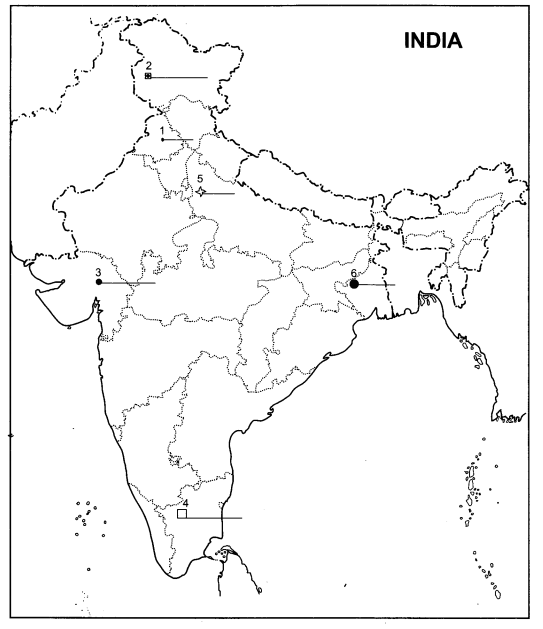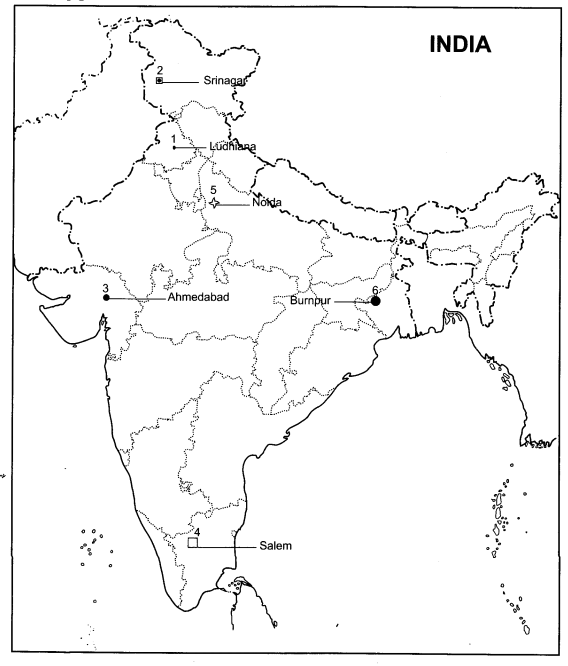CBSE Class 10 Geography Chapter 1 Extra Questions and Answers Resource and Development Pdf free download are part of Extra Questions for Class 10 Social Science. Here we have given NCERT Extra Questions for Class 10 Social Science SST Geography Chapter 1 Resource and Development.
Learnintsa.com Committed to provides Extensive NCERT Solutions for Class 10 Geography Chapter 1 Resource and Development, Students can read and score more marks in your CBSE board examination.
Resource and Development Class 10 Extra Questions Geography Chapter 1
QUESTIONS OF 1 MARK
Answers should not exceed 30 words.
Question 1.
What do you understand by Resource ?
Answer:
Everything available in our environment which can be used to satisfy our needs, provided, it is technologically accessible, economically feasible and culturally acceptable can be termed as ‘Resource’.
Question 2.
Classify resources on the basis of exhaustibility.
Answer:
Renewable and non-renewable resources.
Question 3.
Classify resources on the basis of development.
Answer:
Potential, developed stock and reserves.
Question 4.
Give an example of Biotic resources.
Answer:
Human beings, flora and fauna are examples of biotic resources.
Question 5.
What types of resources are solar and wind energy ?
Answer:
Solar and wind energy are renewable resources.
Question 6.
Mention a non-renewable source that cannot be recycled and get exhausted with their use.
Answer:
Fossil fuel.
Question 7.
What do you understand by international resources ? Give example.
Answer:
These resources are regulated by international institutions. Examples are the oceanic resources beyond 200 km of the Exclusive Economic Zone belong to open ocean and no [ individual country can utilise these without the concurrence of international institutions.
Question 8.
What are developed resources ?
Answer:
Resources which are surveyed and their quality and quantity have been determined for utilisation. The development of resources depends on technology and level of their feasibility.
Question 9.
Which are the results of using resources indiscriminately by human beings ? Mention any one.
Answer:
- Accumulation of resources in a few hands.
- Depletion of resources for satisfying the greed of few individuals.
Question 10.
What is sustainable development ?
Answer:
Sustainable economic development means ‘development should take place without damaging the environment and development in the present should not compromise with the needs of the future generations’.
Question 11.
What was the object of Rio de Janeiro Earth Summit, 1992 ?
Answer:
The Summit was convened for addressing urgent problems of environmental protection and socio-economic development at the global level.
Question 12.
What is Agenda 21 ?
Answer:
It is the declaration signed by world leaders in 1992 at the United Nation’s Conference on Environment and Development which took place at Rio de Janeiro (Brazil).
It aims at achieving global sustainable development. It is an agenda to combat environmental damage, poverty, disease through global cooperation on common interests, mutual needs and shared responsibilities.
Question 13.
Which states in India are rich in minerals and coal deposits ?
Answer:
Jharkhand, Chhattisgarh and Madhya Pradesh.
Question 14.
How did Gandhiji voice his concern about resource conservation ?
Answer:
Gandhiji said, “There is enough for everybody’s need and not for any body’s greed.”
Question 15.
What was the main reason for the colonial countries to exploit resources of countries under their
control ?
Answer:
High level of technological development.
Question 16.
Which report in 1987 introduced the concept of ‘Sustainable Development’ ?
Answer:
Brundtland Commission Report.
Question 17.
How much area of land in India is plain and what is its importance ?
Answer:
About 43 per cent of the land area is plain. It provides facilities for agriculture and industry.
Question 18.
What is the use of mountains ?
Answer:
Mountains ensure perennial flow of some rivers, provide facilities for tourism and ecological aspects.
Question 19.
What is gross cropped area ?
Answer:
Area sown more than once in an agricultural year plus net sown area is known as gross cropped area.
Question 20.
What is total geographical area of India ?
Answer:
3.28 million sq. km.
Question 21.
When the National Forest Policy was formed in India ?
Answer:
1952.
Question 22.
How much degraded land is in India ?
Answer:
At present there are about 130 million hectares of degraded land in India.
Question 23.
Which are the factors that determine the use of land ?
Answer:
The factors are topography, climate, soil types, population, density, technological capability and culture and traditions.
Question 24.
State factors responsible for land degradation.
Answer:
Overgrazing, mining, quarrying and deforestation.
Question 25.
Which are the ways to solve the problems of land degradation ?
Answer:
Afforestation, proper management of grazing, control of mining activities etc.
Question 26.
How mining is responsible for the degradation of land ?
Answer:
Mining sites are abandoned after excavation work is complete leaving deep scars and traces of overburdening.
Question 27.
Mention the states where overgrazing and over-irrigation are responsible for degradation.
Answer:
- Overgrazing – Gujarat, Rajasthan Madhya Pradesh and Maharashtra.
- Over-irrigation – Punjab, Haryana, western Uttar Pradesh.
Question 28.
Which part of India is made of alluvial soil ?
Answer:
The entire Northern Plains are made of alluvial soil.
Question 29.
How are alluvial soils classified on the basis of their age ?
Answer:
According to their age alluvial soils can be classified as old alluvial soil — Bangar and new alluvial – Khadar.
Question 30.
What is the other name of black soils ?
Answer:
Regur soils.
Question 31.
Where are red and yellow soils found ?
Answer:
Red and yellow soils are found in the eastern and southern parts of the Deccan plateau, in parts of Orissa, Chattisgarh, southern parts of the middle Ganga plain and along the piedmont zone of the Western Ghats.
Question 32.
State one feature of laterite soils.
Answer:
The laterite soils are suitable for cultivation with adequate doses of manures and fertilisers.
Question 33.
Which soil is suitable for production of Cashew Nut and where ?
Answer:
Red laterite soil in Tamil Nadu, Andhra Pradesh and Kerala is suitable for the crop of cashew nuts.
Question 34.
What is soil erosion ?
Answer:
The denudation of the soil cover and subsequent washing down is described as soil erosion.
Question 35.
Which are two causes for soil erosion ?
Answer:
Deforestation, overgrazing and mining activities.
Question 36.
What are ravines ?
Answer:
The land that becomes unfit for cultivation is known as bad land. In the Chambal basin such lands are called ravines.
Question 37.
What is the significance of the shelter belts in the desert in western India ?
Answer:
The shelter belts have contributed significantly to the stabilisation of sand dunes and in stabilising the desert in western India.
Question 38.
What is the use of contour ploughing ?
Answer:
Ploughing along the contour lines can decelerate the flow of water down the slopes.
Question 39.
What is use of shelter belts ?
Answer:
Shelter belts contribute significantly to the stabilisation of sand dunes and in stabilising the desert in western India.
QUESTIONS OF 3/4 MARKS
Answers should he in about 80/100 words.
Question 1.
What is meant by resource ? Mention the four basis to classify the resources.
Answer:
(1) Resource : Everything available in our environment which can be used to satisfy our needs provided, it is technologically accessible, economically feasible and culturally acceptable can be termed as resource.
(2) Four basis to classify resources are as mentioned below :
- On the basis of origin – biotic and abiotic.
- On the basis of exhaustibility – renewable and non-renewable.
- On the basis of ownership – individual, community, national and international.
- On the basis of status of development – potential, developed stock and reserves.
Question 2.
Are resources free gifts of nature ?
Answer:
No. Resources are not free gifts of nature. Resources are a function of human activities. Human beings themselves are essential components of resources. They transform material available in our environment into resources and use them.
Question 3.
What are biotic and abiotic resources ? Give two examples for each.
Answer:
On the basis of origin resources are divided as given below :
- Biotic resources : These are obtained from biosphere and have life such as human beings, flora and fauna, fisheries and livestock.
- Abiotic resources : All those things which are composed of non-living things are called aboitic resources e.g., rocks and metals.
Question 4.
Explain the types of resources on the basis of exhaustibility by giving examples.
Answer:
On the basis of exhaustibility, the resources are of two types as mentioned below :
(1) Renewable resources :
- These can be renewed or reproduced by physical, chemical or mechanical process. Examples are solar and wind energy, water and forests.
- The renewable resources may further be divided into continuous or flow and biological,
- Continuous or flow resources are wind and water,
- Biological resources are vegetation (forests) and wildlife,
- These resources are available continuously.
(2) Non-renewable resources :
- They exhaust and take millions of years in their formation.
- Examples are minerals and fossil fuels,
- Some of the resources like metals are recyclable and some like fossil fuels cannot be recycled and get exhausted with their use.
- These resources cannot be regenerated.
Question 5.
Provide a suitable classification for resources on the basis of ownership. Mention main features of any three types of such resources.
Answer:
These are divided as individual, community owned, national and international resources.
(1) Individual resources :
- These are owned privately by individuals,
- Many farmers own land in the villages which is allotted to them by government against payment of revenue,
- Urban people .own plots, houses and other property,
- Plantation, pasture lands, ponds are also owned by individuals.
(2) Community owned resources :
- These are owned by community.
- These are accessible to all the members of the community,
- Village commons (grazing grounds, burial grounds), public parks, picnic spots in urban areas are accessible to all the people living there.
(3) National resources :
- These are owned and belong to the nation or state,
- All the minerals, water resources, forests, wildlife land within the political boundaries and oceanic area upto 12 nautical miles (19.2 km) from the coast termed as territorial water and resources there-in belong to the nation.
(4) International resources :
These do not belong to any country. Some of these resources are regulated by international institutions. Oceanic resources beyond 200 km of the Exclusive. Economic Zone belong to open ocean and no individual country can utilise these without the concurrence of international institutions.
Question 6.
How are the resources divided on the basis of the status of development ? Give example of each type.
Or
Differentiate between stock resources and reserves.
Answer:
These can be divided into four types :
(1) Potential resources : These are found in a region but have not been utilised, e.g., enormous potential for development of wind and solar energy in Rajasthan and Gujarat. But so far these have not been developed properly.
(2) Developed resources :
- Resources whose quality and quantity have been determined for utilisation.
- Their development depends on technology and their level of feasibility.
(3) Stock :
Materials in the environment which can satisfy human needs but human beings do not have the appropriate technology to access these e.g., two components of water — hydrogen and oxygen can be used as a rich source of energy but we, human beings, do not have technology to use them. Hence it is considered as stock.
(4) Reserves :
- These are the subset of the stock which can be used by present technology but their use has not been started fully.
- River water can be used for generating hydroelectric power but presently it is being used only to a limited extent,
- Such resources can be used for meeting future requirements,
- Water in the dams, forests etc. is a reserve which can be used in the future.
Question 7.
Highlight any three problems associated with the indiscriminate use of resources by the human beings.
Answer:
The indiscriminate use of resources by the human beings has resulted in the following :
- Depletion of resources for satisfying the greed of few individuals.
- Accumulation of resources in few hands which has divided the society into rich and poor or have and have nots.
- Indiscriminate exploitation of resources has led to global ecological crises such as global warming, ozone layer depletion, environmental pollution and land degradation.
Thus, an equitable distribution of resources has become essential for a sustained quality of life and global peace. If the present trend of resource depletion by some individuals and countries continues, the future of our planet is in danger.
Question 8.
Why is the issue of sustainability important for development ? Explain.
Answer:
Sustainable development means that a development should meet the needs of the present without compromising the ability of future generations to meet their needs. However, since the second half of the twentieth century, a number of scientists have been warning that the present type and levels of development are not sustainable. The issue of sustainable development has emerged from rapid industrialisation of the world in the past century. It is felt that the economic growth and industrialisation have led to reckless exploitation of natural resources. On the other hand, the stock of natural resources are limited. So, the growth of all countries in future is likely to be endangered if the limited resources are completely exhausted. Under these circumstances, the issue of sustainability has become important for development.
Question 9.
Write a note on the Rio de Janeiro Earth Summit 1992.
Answer:
(1) Place : In June 1992, more than 100 heads of states met in Rio de Janeiro in Brazil for the first International Earth Summit.
(2) Objective : The Summit was convened for addressing urgent problems of environmental protection and socio-economic development at the global level.
(3) Achievements :
- The assembled leaders signed the Declaration on Global Climatic Change and Biological Diversity,
- The Rio convention endorsed the Global Forest Principles and adopted Agenda 21 for achieving Sustainable Development in the 21st century.
Question 10.
Explain Agenda 21.
Answer:
- Declaration : It is the declaration signed by world leaders in 1992 at the United Nations Conference on Environment and Development (UNCED) which took place at Rio de Janeiro (Brazil).
- Aims :
- It aims at achieving global sustainable development.
- It is an agenda to combat environmental damage, poverty, disease through global cooperation on common interest, mutual needs and shared responsibilities,
- One major objective of the Agenda 21 is that every local government should draw its own local Agenda 21.
Question 11.
Explain the consequences of indiscriminate use of resources by human beings. How has the indiscriminate use of resources led to the necessity of resource development or resource planning ?
Or
Why is it essential to have resource planning ? Explain with reasons.
Answer:
- Development of resources or resource development implies not only exploitation, but also preservation and reuse. In case of natural resources, at the time of using them, their nature, type and the size of their reserve should be considered. These should not be used indiscriminately. Therefore, an equitable distribution of resources is necessary for a sustained quality of life and global peace. The resources must not be put to wrong use. This may lead to their depletion.
- Some resources like coal and petroleum are available in limited quantity. If they are continued to be used at the present rate, they would not be left for the future generations.
- Accumulation of resources in a few hands has also restricted equitable access to the resources.
Thus, in view of above factors resource planning is necessary.
Question 12.
“In India some regions are rich in certain types of resources but deficient in some other resources.” Do you agree with the statement ? Support your answer with any three examples.
Answer:
(1) I agree with the statement that in India some regions are rich in certain types of resources but deficient in some other resources as mentioned below :
- Jharkhand, Chhattisgarh and Madhya Pradesh – rich in minerals and coal deposits.
- Arunachal Pradesh – abundance of water resources.
- Rajasthan — lot of solar and wind energy.
- Ladakh – rich cultural heritage.
(2) There is great variation in the availability of resources. Some regions are rich in one resource but deficient in other, as mentioned below :
- Arunachal Pradesh – Lack of infrastructural development.
- Rajasthan – Lack of water resources.
- Ladakh – Deficient in water, infrastructure and vital minerals.
(3) There is lack of technology in some regions. Thus there are regions that are rich in resources but these are included in economically backward regions.
Question 13.
Explain the three stages of Resource Planning in India. [CBSE 2016-17]
Answer:
Three stages of Resource Planning in India are as given below :
- Identification and inventory of resources across the regions of the country. This involves surveying, mapping and qualitative and quantitative estimation and measurement of resources.
- Evolving a planning structure endowed with appropriate technology, skill and institutional set up for implementing resource development plans.
- Matching the resource development plans with overall national development plans.
Question 14.
How did Gandhiji voice his concern about resource conservation ? Explain. [CBSE 2016-17]
Or
What is conservation ? Why is conservation of resources necessary ? What are the views of Gandhiji about resource conservation ?
Answer:
(1) Conservation is defined as the management of resources by human beings in a judicious and planned way without disturbing environment.
(2) It is necessary due to the following reasons :
- We have limited quantity of resources.
- Irrational consumption and over-utilisation of resources may lead to socio-economic and environmental problems.
- It is also required for sustainable development.
(3) Gandhiji said, ‘There is enough for everybody’s need and not for any body’s greed’. He stated that the root cause for resource depletion at the global level was the greedy and selfish individuals and exploitative nature of modern technology. He was against mass production and was in favour of the production by the masses.
Question 15.
Describe the relief features of land in India and their importance.
Answer:
India has a variety of relief features of land i.e., mountains, plateaus, plains and islands.
- 43 per cent of land is plain. It is useful for agriculture and industry.
- 30 per cent of the total land area is mountainous which ensures perennial flow of some rivers. The mountains provide facilities for tourism and ecological aspects.
- 27 per cent area is plateau region which possesses rich reserves of minerals, fossil fuels and forests.
Question 16.
How are land resources used ?
Answer:
Land resources are used for the following purposes :
- Forests.
- Land not available for cultivation.
- Barren and wasteland.
- Land put to non-agricultural uses e.g., buildings, roads and factories etc.
- Other uncultivated land (excluding fallow land).
- Permanent pastures and grazing land.
- Land under miscellaneous tree crops and groves (not included in net sown area).
- Culturable wasteland (left uncultivated for more than 5 agricultural years).
- Fallow lands :
- Current fallow (left without cultivation for Ghe or less than one agricultural year).
- Other than current fallow (left uncultivated for the past 1 to 5 agricultural years).
- Net sown area : Area sown more than once in an agricultural year plus net sown area is known as gross cropped area.
Question 17.
Explain causes for land degradation.
Or
Explain any four human activities which are mainly responsible for land degradation in India.
Answer:
(1) At present there is about 130 million hectares of degraded land in India as mentioned below :
- Forest degraded area — 28%
- Water eroded area — 56%
- Wind eroded area — 10%
- Saline and Alkaline land — 6%
(2) Following factors/human factors are responsible for land degradation in India :
- Mining : Mining sites are abandoned after excavation work is complete leaving deep scars and traces of over burdening.
- Deforestation : In states of Jharkhand, Chhattisgarh, Madhya Pradesh and Orissa deforestation due to mining have caused severe land degradation.
- Overgrazing : In states like Gujarat, Rajasthan, Madhya Pradesh and Maharashtra overgrazing is the main reason for land degradation.
- Over-irrigation : In the states of Punjab, Haryana, Western Uttar Pradesh, over-irrigation is responsible for land degradation due to water logging leading to increase in salinity and alkalinity in the soil.
- The mineral processing like grinding of limestone for cement industry generate dust in the atmosphere. It retards the process of infiltration of water into soil after it settles down on the land. Thus industrial effluents as waste have become a major source of land and water pollution in many parts of the country.
Question 18.
What are the ways to solve the problem of land degradation ?
Answer:
There are many ways to solve the problem of land degradation. These are as given below :
- Afforestation – Plantation of trees should be encouraged.
- Proper management of grazing – Separate sites should be fixed for grazing.
- Planting of shelter belts of plants.
- Control on overgrazing – Rules for grazing should be framed.
- Stabilisation of sand dunes by growing thorny bushes to stop land degradation.
- Proper management of waste lands, control of mining activities, proper discharge and disposal of industrial effluents and wastes after treatment in industrial and suburban areas.
Question 19.
Explain any three factors responsible for the formation of soil.
Or
Give the importance of soil. Explain factors responsible for soil formation.
Answer:
(1) Soil is the most important renewable natural resource. It is the medium of plant growth and supports different types of living organism on the earth.
(2)
- The soil is a living system. It takes millions of years to form soil up to a few centimeter in depth.
- Relief, parent rock or bed rock, climate, vegetation and other forms of life and time are important factors in the formation of soil.
- Various forces of nature such as change in temperature, actions of running water, wind and glaciers, activities of decomposers contribute to the formation of soil.
- Chemical and organic changes which take place in the soil are equally important.
- Soil also consists of organic (humus) and inorganic materials.
Question 20.
How are alluvial soils formed ? How is Bangar different from Khadar ?
Answer:
- Alluvial soils are formed by the deposition by three important Himalayan river systems – The Indus, the Ganga and the Brahmaputra.
- The Bangar is the old alluvial soil. It is less fertile because it has higher concentration of kankar nodules.
The Khadar is the new alluvial soil. It has more fine particles and is more fertile than the bangar.
Question 21.
Describe features of alluvial soils. Name the places where these are found in India.
Answer:
(1) The features of the alluvial soils are explained as below :
- The alluvial soils consist of sand, silt and clay,
- These soils contain adequate proportion of potash, phosphoric acid and lime,
- These soils are ideal for the growth of sugarcane, paddy, wheat and other cereal and pulse crops,
- Soils in the drier areas are more alkaline and need proper treatment and irrigation,
- These soils are of two types – old alluvial soil known as bangar and new alluvial soil known as khadar.
(2) Places : These soils are found in the entire northern plains, Rajasthan, Gujarat (a narrow corridor), eastern coastal plains particularly in the deltas of the Mahanadi, the Godavari, the Krishna and the Kaveri rivers.
Question 22.
What broad category do the soils of Maharashtra fall ?
Or
Mention three characteristics of black soil.
Or
Describe the features of black soil. Name the places where it is found in India.
Answer:
Black soil
(1) Features :
- This soil is black in colour,
- It is also known as regur soil.
- It is ideal for growing cotton and is known as black cotton soil also,
- It is believed that climatic condition along with parent rock material are the important factors for the formation of black soil,
- It is made of clayey material,
- It can hold moisture,
- It is rich in soil nutrients such as calcium carbonate, magnesium, potash and lime,
- It is poor in phosphoric contents, It develops deep cracks during hot weather which helps in the proper aeration of the soil,
- These soils are sticky when wet and difficult to work on unless tilled immediately after the first shower or during the pre-monsoon period.
(2) Places : It is found in Deccan trap (Basalt) region spread over northwest Deccan plateau and is made up of lava flows. They cover the plateaus of Maharashtra, Saurashtra, Malwa, Madhya Pradesh and Chhattisgarh, and extend in the south-east direction along the Godavari and the Krishna valleys.
Question 23.
Describe the features of red and yellow soils. Mention the places where they are found in India.
Answer:
Red and yellow soils :
(1) Features :
- These soils develop reddish colour due to diffusion of iron in crystalline and metamorphic rocks,
- It looks yellow in a hydrated form.
- They are highly porous and fertile when they are fine grained and deep.
(2) Places : Red soil develops on crystalline igneous rocks in areas of low rainfall in the eastern and southern parts of the Deccan plateau. They are also found in parts of Orissa, Chhattisgarh, southern parts of the middle Ganga plain and along the piedmont zone of the Western Ghats.
Question 24.
Describe features of laterite soil. Mention the places where they are found in India.
Answer:
Laterite soil :
(1) Features :
- Laterite has been derived from the Latin word ‘later’ which means brick. It develops in areas with high temperature and heavy rainfall
- Humus content of the soil is low.
- They lack in elements of fertility and are of low value for crop production,
- They are composed of little clay and much gravel of red sandstones,
- They are suitable for cultivation with manures and fertilizers
(2) Places :
- They are found in Karnataka, Kerala, Tamil Nadu, Madhya Pradesh and hilly areas of Orissa and Assam,
- After adopting appropriate soil conservation techniques particularly in the hilly areas of Karnataka, Kerala and Tamil Nadu, this soil is very useful for growing tea and coffee,
- Red laterite soils in Tamil Nadu, Andhra Pradesh and Kerala are more suitable for crops like cashew nut.
Question 25.
Describe the features of Arid soils and Forest soils. Mention the places where they are found in India.
Answer:
(1) Arid soils :
- Features
- They range from red to brown in colour.
- They are generally sandy in texture and saline in nature,
- In some areas the salt content is very high and common salt is obtained by evaporating the water. Due to the dry climate, high temperature, evaporation is faster and the soil lacks humus and moisture,
- The lower horizons of the soil are occupied by kankar because of increasing calcium content downward.
- These soils can become cultivable if irrigation facilities are made available as has been in the case of western Rajasthan.
- Places :
- These soils are found in arid areas of Rajasthan, Punjab and Haryana.
(2) Forest soils :
- Features :
- They are found in mountainous area,
- They are loamy and silty in valley slides and coarse grained in the upper slopes,
- In the snow covered areas of the Himalayas they are acidic with low humus content.
- Places : They are found in the hilly and mountainous areas where sufficient rain forests are available. These places are Meghalaya, Arunachal Pradesh, Uttarakhand, Himachal Pradesh and Jammu and Kashmir. The soils found in the lower parts of the valleys particularly on the river terraces and alluvial fans are fertile.
Question 26.
What is soil erosion ? Write human activities that lead to soil erosion.
Or
Describe the causes for soil erosion.
Answer:
- Soil erosion : The denudation of the soil cover and subsequent washing down is described as soil erosion.
- Causes for soil erosion :
(1) Human activities such as deforestation, overgrazing, constructon, mining and other activities are responsible for soil erosion.
(2) Natural forces like wind, glacier and water also cause erosion :- The running water cuts through the clayey soils and makes gullies. The land becomes unfit for cultivation and is known as bad land. In Chambal basin such lands are called ravines.
- Sometimes water flows as a sheet over large areas down a slope and washes away the top soil. It is known as sheet erosion.
- When wind blows loose soil off flat or sloping land, it is known as wind erosion.
- Soil erosion is also caused by ploughing in a wrong way i.e., up and down the slope from channels for the quick flow of water leading is soil erosion.
Question 27.
Describe measures of soil conservation.
Answer:
The measures for soil conservation are as follows :
- Contour ploughing i.e., ploughing along the contour lines decelerate the flow of water down the slopes.
- Terrace cultivation : Steps are cut on the slopes making terraces which restrict erosion. It is done in western and central Himalayas.
- Strip cropping : It divides large fields into strips. Strips of grass are left to grow between the crops.
- Planting of trees to create shelters are called shelter belts. These shelter belts help in stabilising the desert in western India.
Question 28.
What is the state of India’s environment as depicted by the village Sukhomajri and the district of
Jhabua ?
Or
Describe state of India’s environment with reference to village Sukhomajri and district Jhabua.
Answer:
- The village of Sukhomajri and the district of Jhabua have shown that it is possible to reverse land degradation by plantation of trees. Tree density in Sukhomajri increased from 13 per hectare in 1976 to 1,272 per hectare in 1992.
- Regeneration of the environment has led to economic well-being of the people. The annual average household income in Sukhomajri ranged from ? 10,000-15,000 between 1979 and 1984. This was due to greater resource availability, improved agriculture and animal care.
- Madhya Pradesh government has made people the decision-makers because their participation is essential for ecological restoration. Thus, 2.9 million hectares or 1 per cent of India’s land area are being greened across the state through watershed management.
MAP QUESTION
Question 1.
On the map of India show the places where different types of soils are found.
Answer:
The different types of soils are found as mentioned below :
- Alluvial soils : Entire northern plains, Rajasthan and Gujarat in a narrow corridor, eastern coastal plains in the deltas of the Mahanadi, the Godavari, the Krishna and the Kaveri rivers.
- Black soils : Deccan trap (Basalt) region i.e., plateaus of Maharashtra, Saurashtra,
Malwa, Madhya Pradesh, Chhattisgarh and extend in the southeast direction along the Godavari and the Krishna valleys. - Red and yellow soils : Red soils are found in eastern and southern parts of the Deccan plateau. Yellow and red soils are found in parts of Orissa, Chhattisgarh, southern parts of the middle Ganga Plain and along the piedmont zone of the Western Ghats.
- Laterite soils : Karnataka, Kerala, Tamil Nadu, Madhya Pradesh and the hilly areas of Orissa and Assam.
- Arid soils : Western Rajasthan.
- Forest soils : Areas of Himalayas – the soils on lower parts of the valleys on the river terraces are fertile.
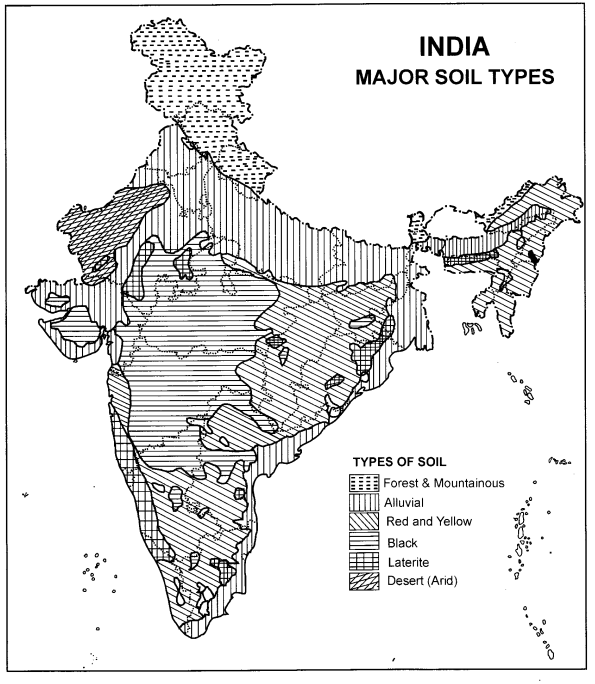
We hope the Extra Questions for Class 10 Social Science Geography Chapter 1 Resource and Development help you. If you have any query regarding Extra Questions for Class 10 Social Science Geography Chapter 1 Resource and Development, drop a comment below and we will get back to you at the earliest.
